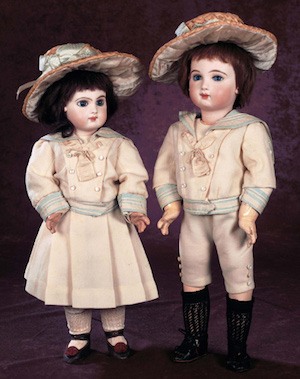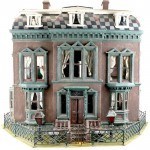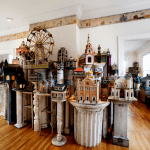
Japanese temple dollhouse commissioned by Huguette Clark in the early 1930s. It is part of the collection that attracted the attention of the FBI investigating Japanese sympathizers after the attack on Pearl Harbor.
Huguette Clark and the ‘FBI’ Dollhouse
The dollhouse miniature universe is populated by so many interesting people. Some of the most fascinating are the collectors, and perhaps Huguette Clark is the most intriguing of them all. Besides owning an outstanding collection of dolls and miniatures, she was hounded by the FBI in two separate investigations. She also holds the title of the most notorious recluse on Fifth Avenue.
The Japanese Connection
Clark collected dolls by the hundreds and had a vast collection of artifacts. She commissioned miniature models of Japanese temples, castles, teahouses, cake shops, and other buildings, which attracted the interest of the FBI.
Determined to have the most authentic dollhouses possible, the Japanese miniatures were designed and built by artists in Japan. The Japanese temple pictured above required special permission from the Japanese government to use a rare cedar generally reserved for imperial buildings and castles. It took three years to build and cost $80,000 ($1,435,200 today). As with all the dollhouses, the temple has a detachable roof so she could see the furnishings inside.
“She was just a delightful person,” said Caterina Marsh, her go-between with these artists. “’She developed an incredible knowledge about the art and culture of Japan. It was astonishing what she knew, all the legends and folklore. To me, she was the last of an era.”
After the attack on Pearl Harbor in 1941, the FBI reviewed companies and individuals having significant contact with Japan. Clark was such a well-known admirer of Japanese culture and art that when investigators analyzed her purchases, an incredibly expensive dollhouse with an unusual Japanese government document included in the shipping documents caused the agents to request a chat, which led to numerous interviews – her attorney described them as interrogations – that dragged on for months. It is thought this may have been the beginnings of her fear of the outside world.
Anything For The Dolls
Clark built her doll collection in an unusual way. For decades, Theriault’s, the world-famous doll auctioneers, would exchange notes and catalogs anonymously with one of its most prominent doll collectors, corresponding only through attorneys.
“It was intriguing,” Stuart Holbrook, president of Theriault, said. “For many years we had no idea who she was ― she was only known as the Client.”
Her enthusiasm for collecting dolls appeared to know no bounds. When she was 86, Mrs. Clark paid $30,000 for a pair of French dolls. She had authorized a bid of up to $135,000.
Paul Clark Newell, Jr. tells the story of how a fashion show got his aunt to leave the “safety” of her apartment. ‘The house of Christian Dior held fashion shows at the palatial French consulate in New York, just up Fifth Avenue from my aunt’s apartment. A familiar name showed up on the guest list.
“Mrs. Huguette Clark!” exclaimed the consul general, Baron Jacques Baeyens, who had married Huguette’s niece.
“Look, she’s not going to come,” Paul Clark said. “She’s my aunt, and she never goes out.”
The representative from Christian Dior replied, “Oh, yes, she will. She wants to see the dresses to dress her dolls.”
And she did. Clark, then 50, walked the three blocks up Fifth Avenue and enjoyed the show.
Home to the collection was one of the three apartments Clark owned 907 Fifth Avenue. She lived in one apartment; the doll had two – one apartment housed the main group, the second handled the overflow. Of the 1,157 antique dolls in her collection at one point, 600 were Japanese, 400 French and German, the balance of miscellaneous origin. At her death, the collection was appraised at $1.7 million.
Shutting Out The World
Huguette Clark had been socially active until her mother’s death in 1963, but she always had her fears. Like many people of her class, the kidnapping of the Lindberg baby left life-long psychic scars. She was afraid to visit France because another revolution could occur. After her mother’s death, her many fears and memories of the war in the Pacific and the FBI investigation caused her to retire from the world.

Huguette Clark lived most of her life in seclusion at 907 Fifth Avenue, overlooking Central Park. Image found in the Daily Mail.
The secluded life suited Clark well until 1991 when lesions on her face were diagnosed as advanced skin cancer. She was rushed to Doctor’s Hospital (now Beth Israel North), where after a few months stay, her condition was stabilized.
When it came time to be discharged, she refused to leave, having adjusted to a more social routine. Clark continued to live pretty much as she had in her apartment, keeping her assistants busy with her collections, and her attorneys with the affairs of anxious heirs to the family copper-mining fortune. She spent the last 20 years of her life at the hospital.
Here Come The Feds – Again
Her second experience with the FBI occurred while she was in residence at Beth Israel North. Clark became aware that Degas “Dancer Making Point” had disappeared from her Fifth Avenue apartment. In those days, art theft was investigated by the FBI. In order to avoid dealing with the agents again, Clark tried to squash the investigation. The FBI ignored her and discovered the painting hanging on Henry Bloch’s (H&R Bloch) living room wall in Kansas City. It’s a fascinating but convoluted story, too long to tell here, except to say that Mr. Bloch had purchased it in good faith. Click on the Ballerina photo for the full story.
I hope you enjoyed this post. I like to learn about the individuals who helped raise dollhouses from playthings for children to an art form. Collectors have been an essential part of this achievement.
Susan Downing, with Patrick Owens
_________________________________________________________________________
I invite you to visit my Etsy Shop where I offer many accessories and pieces of furniture in 1:12 scale.







